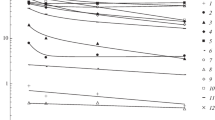Abstract
Distribution coefficients were obtained for yttrium and the rare earth elements (YREEs) in aqueous solutions containing freshly precipitated hydroxides of trivalent cations (Fe3+, Al3+, Ga3+, and In3+). Observed patterns of log i K S–, where i K S = [MS i ][M3+]−1[S i ]−1, [MS i ] is the concentration of a sorbed YREE, [M3+] is the concentration of a free hydrated YREE ion, and [S i] is the concentration of a sorptive solid substrate (Fe(III), Al, Ga, In)– exhibited similarities to patterns of YREE solution complexation constants with hydroxide (OH β 1) and fluoride (F β 1), but also distinct differences. The log i K S pattern for YREE sorption on Al hydroxide precipitates is very similar to the pattern of YREE hydroxide stability constants (logOH β 1) in solution. Linear free-energy relationships between log i K S and logOH β 1 showed excellent correlation for YREE sorption on Al hydroxide precipitates, good correlation for YREE sorption on Ga or In hydroxide precipitates, yet poor correlation for YREE sorption on Fe(III) hydroxide precipitates. Whereas the correlation between log i K S and logF β 1 was generally poor, patterns of log( i K S/F β 1) displayed substantially increased smoothness compared to patterns of log i K S. This indicates that the conspicuous sequence of inflections along the YREE series in the patterns of log i K S and logF β 1 is very similar, particularly for In and Fe(III) hydroxide precipitates. While the log i K S patterns obtained with Fe(III) hydroxide precipitates in this work are quite distinct from those obtained with Al, Ga, and In hydroxide precipitates, they are in good agreement with patterns of YREE sorption on ferric oxyhydroxide precipitates reported by others. Furthermore, our log i K S patterns for Fe(III) hydroxide precipitates bear a striking resemblance to predicted log i K S patterns for natural surfaces that are based on YREE solution chemistry and shale-normalized YREE concentrations in seawater. Yttrium exhibits an itinerant behavior among the REEs: sorption of Y on Fe(III) hydroxide precipitates is intermediate to that of La and Ce, while for Al hydroxide precipitates Y sorption is similar to that of Eu. This behavior of Y can be rationalized from the propensities of different YREEs for covalent vs. ionic interactions. The relatively high shale-normalized concentration of Y in seawater can be explained in terms of primarily covalent YREE interactions with scavenging particulate matter, whereby Y behaves as a light REE, and primarily ionic interactions with solution ligands, whereby Y behaves as a heavy REE.
Similar content being viewed by others
Author information
Authors and Affiliations
Corresponding author
Rights and permissions
About this article
Cite this article
Quinn, K.A., Byrne, R.H. & Schijf, J. Comparative Scavenging of Yttrium and the Rare Earth Elements in Seawater: Competitive Influences of Solution and Surface Chemistry. Aquatic Geochemistry 10, 59–80 (2004). https://doi.org/10.1023/B:AQUA.0000038959.03886.60
Issue Date:
DOI: https://doi.org/10.1023/B:AQUA.0000038959.03886.60




